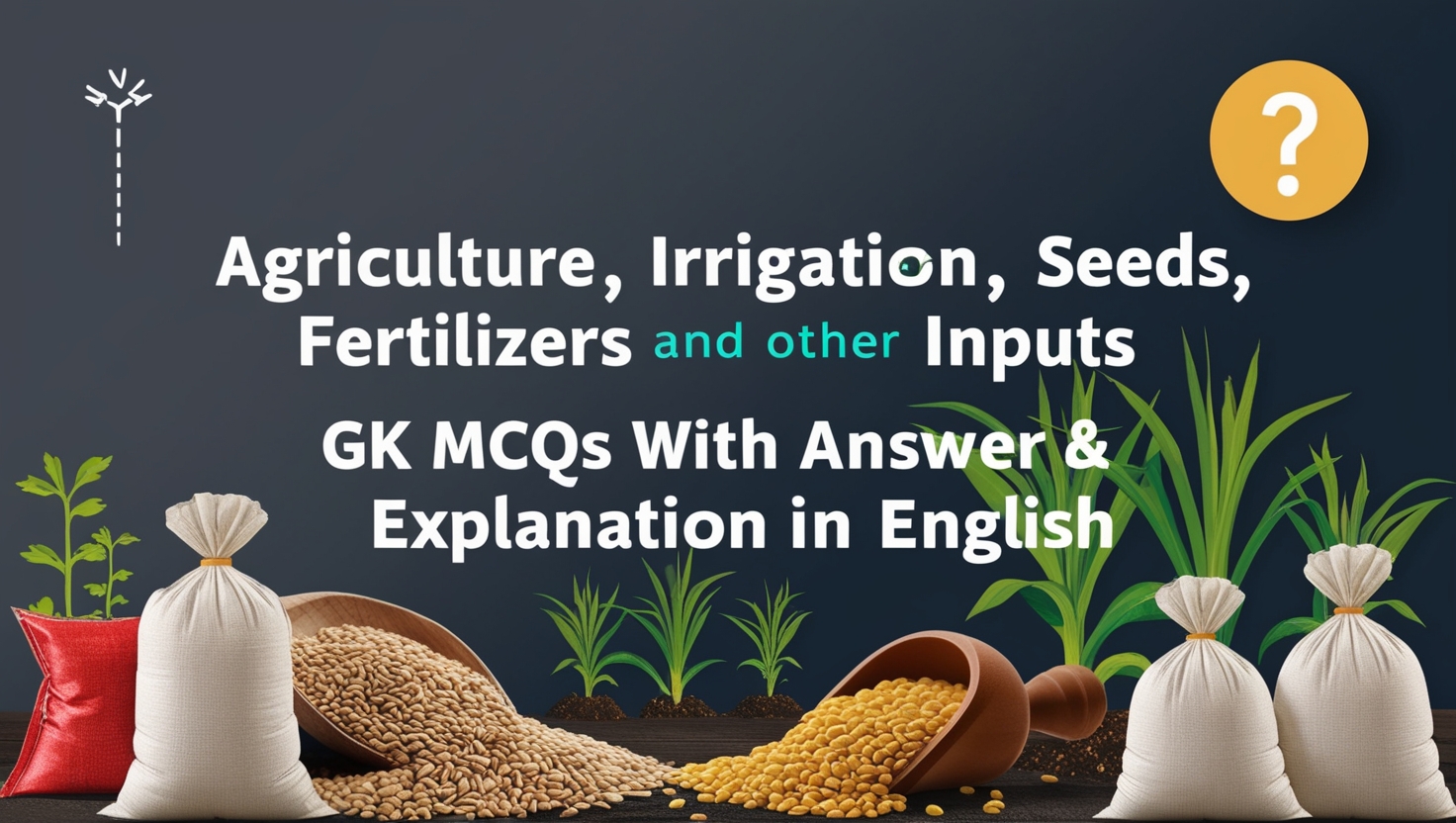
Agriculture forms the backbone of many economies, and understanding its components is essential for appreciating its impact on society. This article, titled Agriculture, Irrigation, Seeds, Fertilizers and other Inputs GK MCQs With Answer & Explanation in English, provides a comprehensive set of multiple-choice questions to test and enhance your knowledge of key agricultural concepts.
From irrigation techniques to seed types and fertilizers, each question is designed with detailed answers and explanations to deepen your understanding. Whether you’re a student, competitive exam aspirant, or agriculture enthusiast, dive in to broaden your insights into the essential inputs that sustain agriculture.
1. Which among the following fertilisers is least likely to affect the Soil pH?
- Urea
- Rock Phosphate
- Ammonia
- Muriate of potash
Show Answer
Answer: Muriate of potash
Among N (Nitrogen), P (Phosphorus), and K (Potassium), Potassium fertilizers are least likely to affect the soil pH. Nitrogen fertilizers can make the soil more acidic or alkaline. Soil pH is a measure of the soil’s acidity or alkalinity, and it can be influenced by different fertilizers. Nitrogen-based fertilizers, when used in excess, can lead to soil acidification, while phosphorus-based fertilizers can affect soil pH by making it more alkaline. However, potassium fertilizers have a minimal impact on soil pH, making them the least likely to alter the soil’s acidity or alkalinity.
2. Highest percentage of nitrogen is found in which among the following fertilisers among the given options?
- Calcium ammonium nitrate
- Ammonium nitrate
- Calcium nitrate
- Urea
Show Answer
Answer: Urea
Urea has the highest nitrogen content among the given options, containing 46% nitrogen. Urea is a widely used nitrogen-based fertilizer known for its high nitrogen content. It consists of 46% nitrogen by weight, making it one of the most nitrogen-rich fertilizers available. This high nitrogen content makes urea an essential choice for providing plants with a readily available source of nitrogen for growth and development.
3. Which among the following is the largest source of irrigation in India, apart from rains?
- Tubewells
- Canals
- Rivers
- Tanks
Show Answer
Answer: Tubewells
Tubewells are the largest source of irrigation in India after rainfall. Tubewells, which provide groundwater-based irrigation, play a significant role in supplementing agricultural water needs in India. They are a vital source of irrigation, especially in regions where rainfall is insufficient or unreliable. After natural rainfall, tubewells are among the most important sources of irrigation, enabling farmers to access groundwater for their crops.
4. Which among the following revolutions is related to ‘fertilisers’?
- Silver Revolution
- Grey Revolution
- Golden Revolution
- Pink Revolution
Show Answer
Answer: Grey Revolution
Grey Revolution is related to ‘fertilizers.’ The term “Grey Revolution” is not commonly associated with fertilizers or any specific agricultural revolution. Instead, “Grey Revolution” is more closely related to developments in the poultry industry, particularly focusing on the substantial growth and expansion of the poultry sector, including the production of eggs and poultry meat.
5. Consider the following: Medium Irrigation Scheme:
1. CCA more than 2000 Hectares
2. but less than 10000 Hectares
Choose the correct option from the codes given below:
- Only 1 and 2 are correct
- Only 2 and 3 are correct
- All are correct
- All are incorrect
Show Answer
Answer: Only 1 and 2 are correct
The Medium Irrigation Scheme has a Culturable Command Area (CCA) of more than 2000 hectares but less than 10000 hectares. In the context of irrigation schemes, a Medium Irrigation Scheme typically refers to a project with a Culturable Command Area (CCA) that falls within the range of more than 2000 hectares but less than 10000 hectares. This scheme aims to provide irrigation water to the specified land area to support agricultural activities.
6. Which of the following places in the world is known for ‘Guano’, a uniquely-produced natural fertiliser which has a high concentration of nitrates?
- Tierra del Fuego
- Atacama desert
- Minas Gerais of Brazil
- Coastal headlands and Islands of Peru
Show Answer
Answer: Coastal headlands and Islands of Peru
Guano’ is collected from the coast of Peru and is rich in nitrates. Guano is a valuable natural fertilizer composed of bird droppings, primarily collected from the coast of Peru and other seabird habitats. It is rich in nitrates and essential nutrients, making it an excellent source of organic fertilizer. The term “guano” is often associated with nitrogen-rich fertilizers derived from seabird excrement.
7. In India, Tank irrigation is more common in which of the following regions?
- Rocky plateau regions with uneven and highly seasonal rainfalls
- Regions with the presence of perennial rivers and plenty of rainfall
- Arid and Semi-Arid regions with scanty rainfall
- Coastal regions with regular rainfall
Show Answer
Answer: Rocky plateau regions with uneven and highly seasonal rainfalls
Tank irrigation is more common in the rocky plateau areas of India where the rainfall is uneven and highly seasonal. Tank irrigation is a prevalent form of water resource management in regions of India characterized by uneven and highly seasonal rainfall, particularly in the rocky plateau areas. Tanks, or reservoirs, are constructed to capture and store rainwater, providing a reliable source of water for irrigation during dry periods.
8. Consider the following statements about Kul Irrigation technique:
A) The technique is most prevalent in southern India
B) The method involves natural or artificial removal of surface and subsurface water from a given area
Choose the correct option from the codes given below:
- 1 Only
- 2 Only
- Both 1 & 2
- Neither 1 nor 2
Show Answer
Answer: Neither 1 nor 2
Both statements are incorrect. Kul Irrigation technique is most prevalent in the Himalayan region, and it involves the contribution to farming by utilizing kuls (diversion channels) to carry water from glaciers to villages. Kul irrigation is a traditional water management system in the Himalayan region, where glacial meltwater is channeled through kuls to provide water for agriculture in the terraced fields. This technique helps sustain agriculture in the hilly terrain, and its practice is widespread in the Himalayan states.
9. Consider the following statements about Lift irrigation:
1 In this type of irrigation technique, water is directed from the source of supply to farm lands through natural means.
2. India’s first lift irrigation project has been inaugurated in Punjab.
Choose the correct option from the codes given below:
- 1 Only
- 2 Only
- Both 1 & 2
- Neither 1 nor 2
Show Answer
Answer: Neither 1 nor 2
Statement 1 is incorrect. Lift Irrigation is a method in which water is not transported by natural flow but is lifted with pumps or other means. Statement 2 is incorrect. India’s first lift irrigation project has been started in Andhra Pradesh, not Punjab. The Pattiseema lift irrigation project in Andhra Pradesh is the country’s first lift irrigation project, connecting Godavari with Krishna.
10. Consider the following differences between drip irrigation and surface irrigation:
1. Drip irrigation is more water-efficient than surface irrigation for vegetable planting.
2. While surface irrigation is more suited to sandy soil, drip irrigation is suited to loamy soil.
Choose the correct option from the codes given below:
- Only 1
- Only 2
- Both 1 & 2
- Neither 1 nor 2
Show Answer
Answer: Only 1
The first statement is correct. Drip irrigation is more water-efficient than surface irrigation, especially for vegetable planting. However, the second statement is incorrect because drip irrigation is more suited to sandy soil, not loamy soil.







